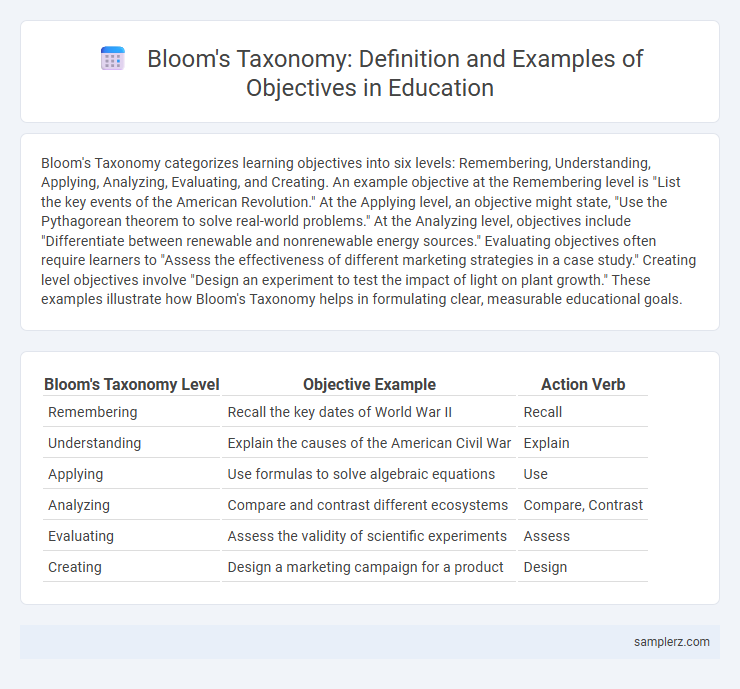Bloom's Taxonomy categorizes learning objectives into six levels: Remembering, Understanding, Applying, Analyzing, Evaluating, and Creating. An example objective at the Remembering level is "List the key events of the American Revolution." At the Applying level, an objective might state, "Use the Pythagorean theorem to solve real-world problems." At the Analyzing level, objectives include "Differentiate between renewable and nonrenewable energy sources." Evaluating objectives often require learners to "Assess the effectiveness of different marketing strategies in a case study." Creating level objectives involve "Design an experiment to test the impact of light on plant growth." These examples illustrate how Bloom's Taxonomy helps in formulating clear, measurable educational goals.
Table of Comparison
| Bloom's Taxonomy Level | Objective Example | Action Verb |
|---|---|---|
| Remembering | Recall the key dates of World War II | Recall |
| Understanding | Explain the causes of the American Civil War | Explain |
| Applying | Use formulas to solve algebraic equations | Use |
| Analyzing | Compare and contrast different ecosystems | Compare, Contrast |
| Evaluating | Assess the validity of scientific experiments | Assess |
| Creating | Design a marketing campaign for a product | Design |
Understanding Bloom’s Taxonomy for Educational Objectives
Understanding Bloom's Taxonomy for educational objectives involves categorizing learning goals into cognitive levels such as Remembering, Understanding, Applying, Analyzing, Evaluating, and Creating. An example objective at the Understanding level is: "Explain the concept of photosynthesis in your own words," which demonstrates comprehension beyond mere memorization. This taxonomy guides educators in designing objectives that foster deeper cognitive engagement and measurable student learning outcomes.
Knowledge Level: Recognizing and Recalling Information
At the Knowledge Level of Bloom's Taxonomy, objectives focus on recognizing and recalling facts, terms, and basic concepts. For example, students might be asked to list key dates in history, define scientific vocabulary, or identify parts of a plant diagram. This foundational cognitive skill supports deeper learning by ensuring accurate memory retrieval of essential information.
Comprehension Level: Explaining Concepts in Your Own Words
At the Comprehension Level of Bloom's Taxonomy, objectives focus on students demonstrating understanding by explaining concepts in their own words. For example, an objective might require students to summarize the main ideas of a text or interpret a scientific principle using everyday language. This approach ensures students process information meaningfully and solidify their grasp of foundational knowledge.
Application Level: Using Knowledge in Real-Life Scenarios
Incorporating Bloom's Taxonomy at the Application Level emphasizes students' ability to transfer theoretical knowledge to practical, real-world contexts. For example, a science objective might require learners to design an experiment applying principles of physics to solve everyday problems. This approach enhances critical thinking by encouraging application of concepts such as force and motion beyond the classroom environment.
Analysis Level: Breaking Down Information into Components
At the Analysis level of Bloom's Taxonomy, an objective might involve students examining a scientific experiment by identifying its variables, hypothesis, and methodology to understand how each component contributes to the overall outcome. Learners break down complex texts into main ideas, supporting details, and underlying assumptions to evaluate the structure and logic. This approach enhances critical thinking by encouraging the deconstruction of information into manageable parts for deeper comprehension.
Synthesis Level: Creating New Ideas from Existing Concepts
Bloom's Taxonomy at the Synthesis Level emphasizes the ability to combine existing knowledge to generate innovative ideas or solutions. An objective example includes students designing a new marketing campaign by integrating concepts from consumer behavior, branding, and digital media strategies. This cognitive process encourages creative problem-solving and the development of original projects that reflect comprehensive understanding.
Evaluation Level: Making Judgments Based on Criteria
An example of a Bloom's Taxonomy objective at the Evaluation level is for students to critique a scientific study by assessing the methodology, data validity, and conclusions drawn. Learners evaluate sources for credibility and relevance, making informed judgments grounded in established criteria. This skill develops higher-order thinking essential for academic research and decision-making.
Crafting Objectives Using Bloom’s Taxonomy Verbs
Crafting objectives using Bloom's Taxonomy verbs enhances clarity and measurability by aligning learning goals with cognitive levels such as Remembering, Understanding, Applying, Analyzing, Evaluating, and Creating. For example, an objective at the Applying level might be "Solve algebraic equations using appropriate formulas," while an Evaluating objective could state "Critique the effectiveness of different teaching strategies based on student outcomes." Utilizing specific action verbs like "Define," "Interpret," "Demonstrate," "Compare," and "Design" targets the intended cognitive skills and improves instructional focus.
Examples of Bloom’s Taxonomy in Lesson Planning
Bloom's Taxonomy in lesson planning includes objectives such as "Analyze the causes of the American Revolution" for higher-order thinking skills, "Describe the main events of World War II" to target comprehension, and "Recall key dates and figures in the Civil Rights Movement" to emphasize knowledge retention. These objectives guide educators in scaffolding learning from remembering and understanding to applying and evaluating information effectively. Integrating such examples ensures lesson plans address diverse cognitive levels, promoting deeper student engagement and mastery.
Assessing Student Learning through Bloom’s Taxonomy
Assessing student learning through Bloom's Taxonomy involves creating objectives that target various cognitive levels, such as analyzing, evaluating, and creating. For example, an objective might require students to evaluate case studies or design experiments, promoting higher-order thinking skills. This approach ensures comprehensive assessment by measuring understanding from basic knowledge recall to complex application and critical thinking.

example of bloom’s taxonomy in objective Infographic
 samplerz.com
samplerz.com